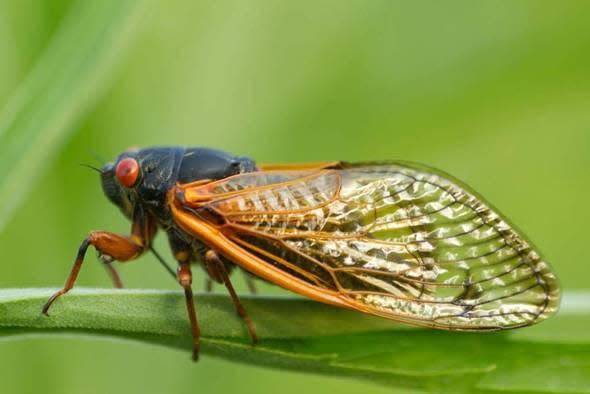Periodical cicadas may be dying off, but their effects may linger through next summer
As June wraps up, the cicada symphony is coming to an end, but homeowners may see some lingering effects of the summertime insects.
In parts of the state that experienced the cicada swarm, folks may notice heavily-damaged twigs or branches and yellowing or browning leaves. This is known as flagging.
As Springfield and Columbia only experienced the emergence of one cicada brood this summer — Brood XIX — homeowners may not even see any tree damage.
What causes flagging?
Flagging occurs when female cicadas lay their eggs on tree branches and twigs. Cicadas specifically flock to apple, hickory, maple and oak trees, University of Missouri Extension forestry state specialist Hank Stelzer told the News-Leader. They may also lay eggs on blueberry, rose, lilac and forsythia bushes.

Female cicadas use a saw-like appendage on their abdomens to slice the undersides of 1/8- to 1/2-inch diameter twigs to deposit their eggs, according to the Missouri Department of Conservation. Each female cicada lays about 400-600 eggs per summer.
After 6-10 weeks, the eggs hatch and baby cicadas, known as nymphs, emerge and burrow underground. The nymphs then find a healthy root system for feeding. They will remain here for 13 years before they emerge as full-grown adults.
What is the harm of flagging?
For the most part, flagging is a cosmetic issue, Stelzer said. If homeowners didn't properly protect their trees ahead of the cicada swarm, there's nothing they can do now to help their trees.

If homeowners notice flagging on mature trees, there's no need to fret. Injured branches may break off later this summer or during a winter storm, while others may hold out until next year. Either way, a healthy, mature tree is not in danger.
On the other hand, young trees — those below 12-15 feet in height — may be at risk for long-term damage.
If a young tree still looks damaged by next summer, Stelzer recommends contacting a certified arborist to check it out.
In the worst cases, incisions created by female cicadas may not close properly, serving as entryways for canker diseases, which cause dead bark and wood on trees.
More: Ask the Master Gardener: Curious about companion planting? Plus tips for tomatoes, peppers
Ultimately, Stelzer advised: "Don't panic. Go ahead and let the tree do its thing this year."
Homeowners do not need to prune any flagging damage they find on trees. It's best to just let the trees handle themselves.
Decomposing cicadas
Homeowners who find dead cicada carcasses should leave them be, as the decomposing bodies benefit trees and plants. According to MU Extension, benefits include:
Nymph exoskeletons and adult carcasses serve as natural fertilizer;
Carcasses serve as food supply for wildlife, especially birds raising their young;
Soil is aerated as nymphs emerge from underground;
Outer branches are naturally pruned, which could lead to more branches, flowers and fruit in the coming years.
Greta Cross is the trending topics reporter for the Springfield News-Leader. She has more than five years of journalism experience covering everything from Ozarks history to Springfield’s LGBTQIA+ community. Follow her on X and Instagram @gretacrossphoto. Story idea? Email her at gcross@news-leader.com.
This article originally appeared on Springfield News-Leader: Dead tree twigs, leaves may be result of female cicadas laying eggs

